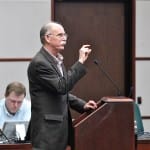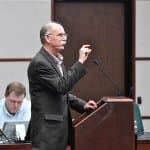Zoning board doesn’t yield to COVID-19, grants driveway variances for 4th Street parking garage; Bloomington city council cancels work session




On Thursday night in Bloomington, as the COVID-19 pandemic stalled a lot of public business, some of the People’s work was still getting done.
At the regular meeting of the city’s board of zoning appeals (BZA), a replacement garage at 4th and Walnut streets in downtown got two required variances.
The BZA’s Thursday action clears the way for construction of the project, which is hoped to start sometime around August this year, and be complete in August of 2021.
The BZA’s approval followed the project’s site plan approval by the city’s plan commission almost two weeks ago. Of the 537 spaces to be constructed in the new garage, 352 count as replacements for the spaces that were previously housed in the 4th Street structure, which was closed at the end of 2018 due to structural issues.
The design approved by the plan commission is at the same site, on the same footprint, where the old 4th Street parking garage stood, until it was demolished in late 2019.
The city of Bloomington’s attempt to build the replacement garage on a larger footprint foundered on an unsuccessful eminent domain action to take the JuanSells.com building at the south end of the block. The city filed a notice of appeal, but has moved ahead with a design that does not require the additional real estate. [Updated March 20, 2020: Bloomington announced on March 20 that the city is moving to withdraw its appeal.]
The court clerk’s completion of the lower court’s transcript, on March 13, started the 30-day clock for Bloomington to file its first brief, if the city wants to follow through on a challenge to the ruling in Monroe’s circuit court.
One variance granted by the BZA on Thursday allows the parking structure’s entrance driveway to be wider than would ordinarily be allowed under city code. Another variance allows the driveway to be closer to Walnut street than the code allows.
COVID-19: BZA compared to city council work session
In light of Indiana governor Eric Holcomb’s emergency order issued on Tuesday, any public meeting of a governmental entity is supposed to be “limited to only essential matters critical to the operations of the governmental agency or entity for the duration of this public health emergency.”
Besides the 4th Street parking garage variances, two other items appeared on the BZA agenda for Thursday. They were put off for now.
Why was the item involving the 4th Street parking structure left on the BZA agenda? Responding to that question from The Square Beacon, Bloomington’s director of public engagement, Mary Catherine Carmichael, said the item on the parking structure variances was consistent with the governor’s order.
Local business were already impacted by the closure of the garage Carmichael said, even before the COVID-19 pandemic forced restaurants and bars to close for dine-in service. Downtown businesses are really “taking it on the chin,” she said, and that’s why the city wanted to keep this public business going forward.
The Bloomington city council reached a different decision about its work session that was noticed to the public earlier in the week. In light of the governor’s order, it was cancelled shortly after notice was posted.
Responding to a question from The Square Beacon, deputy council administrator/attorney Stephen Lucas said, “After reevaluating the Council’s upcoming meeting schedule, Council leadership decided the work session wasn’t a necessary public meeting, in light of the executive order issued by the Governor a few days ago.”
City council president Steve Volan told The Square Beacon the work session was supposed to be “basically a conference-call update [on COVID-19] for members who might not all be up to date on everything happening around us.” After further consideration, Volan said, “We determined that that wasn’t kosher under the new guidelines set by the governor.”
Volan indicated the council’s meeting for next Wednesday, March 25, is still on the calendar. At that meeting, the council is expected to vote on the re-funding of some waterworks bonds that could save the city around $2.3 million.
Volan said staff are working on ways to conduct a public meeting where the public can also participate remotely. [Updated early evening March 20, 2020: Statement from council president Steve Volan posted on Facebook.]
BZA: An experiment in public participation
One of the technology platforms that the city is considering to allow the public to watch and interact with government officials during a meeting is Facebook live streaming. It was tried out on an experimental basis for Thursday’s BZA meeting.

Facebook live streaming is not intended as a substitute for streaming by Community Access Television Services (CATS). Michael White told The Square Beacon: “We’re doing our best to continue limited coverage.”
CATS is headquartered at the Monroe County Public Library, which is closed through April 6. Marilyn Wood, director of the Monroe County Public Library, told The Square Beacon that CATS staff will still have access to their equipment to cover public meetings.
The feature that Facebook provides, which CATS does not, is the ability for viewers to comment online during the meeting.
The mayor’s office tried out the Facebook live streaming for Thursday’s BZA meeting, using a combination of three smartphones to capture different angles for the video feed, including an inset for the public podium.
BZA OKs both variances
Speaking from the public podium at Thursday’s meeting was Greg Alexander, who questioned the need for a driveway entrance and exit on 4th Street that is 39 feet wide, when the maximum width under code is 24 feet.
Alexander said he understands the reason why the city wanted the driveway to have three lanes. (One of the lanes can serve either entrance or exit, depending on the time of day—entrance for early in the day, when the garage is filling up, and exit when people get off work and the garage is emptying out.)

But the wider driveway means that pedestrians who are walking along Fourth Street across the driveway entrance, have a longer span to cover, so they’re exposed longer to car traffic, Alexander said.
Alexander also pointed to the fact that drivers who are exiting, turning right, are encouraged by the physical configuration to look left, which means that drivers won’t see a pedestrian on their right. That’s the same kind of configuration that Alexander said had led to the death of a pedestrian at 3rd and Washington in February and another at the downtown Bloomington Transit center in September.
Board members asked the project’s engineer, Bill Riggert, with Bledsoe Riggert Cooper & James, to respond to Alexander’s remarks.
With respect to the width, Riggert said there are structural columns that take up some of the space, and they can’t be eliminated. The payment equipment also takes up width, he said. With respect to ways to address the pedestrian safety issue, Riggert pointed to mirrors that have been installed at the Morton Street garage that help drivers see around the corner.
Some other options had been considered, Riggert said, but it wasn’t felt they were appropriate—for example, a mechanism that would trigger the illumination of the walking surface as a car approaches the exit, to alert a pedestrian that a car would be exiting.
Riggert said, “In a city where you have to have parking garages and driveways, pedestrians also have to play a part in being alert and understanding, just like at a signalized intersection…I would think pedestrians also would be cautious walking in front of a garage, and the drivers leaving should be looking both ways.”
Board members wanted to know why the stair tower had to be located in the northwest corner, instead of the northeast corner, which could allow the driveway to be moved far enough away from Walnut Street to meet the code requirement of 100 feet minimum separation. The proposed design puts the driveway just 65 feet away from Walnut street.
Riggers pointed to the existing bridge connection from Fountain Square, which is planned to be restored in the replacement structure. The most natural place for that bridge to enter the parking structure would be at the stair tower, Riggert said, and that meant putting the tower at the northwest corner.
The tally for the joint motion on both variances was 4–0.




Comments ()